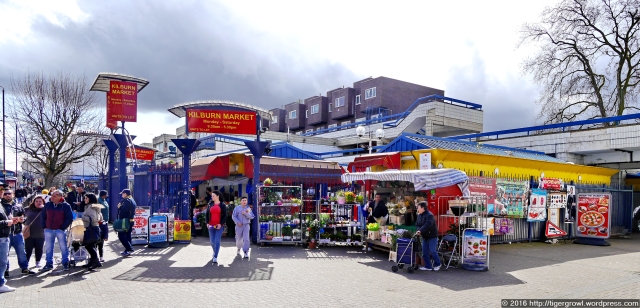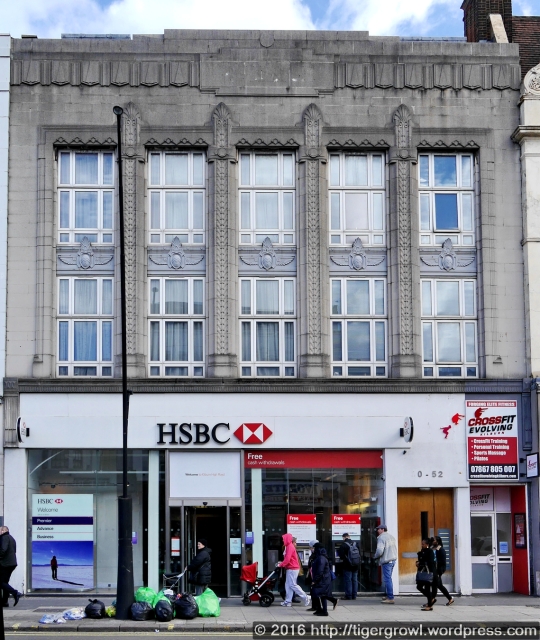Tuesday, March 29th 2016
Kilburn is a well known and populous district of London which spreads itself among three boroughs, those of Brent, Camden and Westminster. Like many parts of London, it has known successive waves of immigration, which have left it with a varied set of ethnic communities, the largest of which is the Irish community. The origin of its name is uncertain. There are several theories but insufficient evidence to allow us to choose between them. It is certain, though, that the second syllable, ‘burn’, meaning a river or stream, refers to the watercourse that runs through the area and is today called the Westbourne. As for the first syllable, ‘Kil’, the suggestion that I like best (though there is no more evidence for it than for the others) is that it comes from the Anglo-Saxon personal name Cylla, suggesting that a man thus called established himself here, beside the river, and gave his name to his farmstead. The Westbourne, unfortunately, was covered over long ago and today belongs to the group of London’s lost or hidden rivers.
We arrived at Kilburn by the Jubilee Line of the London Underground. Many stations on the ‘underground’, especially away from the centre of London, are in fact above ground and even, as in the case of Kilburn Station, above street level. Jubilee Line trains run on the inner tracks and stop at all stations, while the outer tracks carry Metropolitan Line trains that sail through to the outer reaches.

Kilburn Station at street level
Originally known as Kilburn and Brondesbury, the station opened in 1879 as a stop on the Metropolitan Railway route. Today, the London Underground’s Jubilee Line calls here and the station is named simply Kilburn. It is a Grade II listed building.
We passed under the two bridges carrying the Underground lines (one bridge for each direction) and started along Kilburn High Road. This follows a track or road that existed since ancient times, even before the arrival of the Romans who paved it and made it part of their Watling Street. It continues behind us, where it is known by the picturesque name of Shoot-Up Hill, but we followed it as it trends roughly south-east towards another name change.
Street artists had been at work under the bridges, though I do not know the name of the painter of this work. It is quite a complex piece but seems to have faded a little with age.
Being a main artery, Kilburn High Road is well supplied with pubs, as you would expect. Some of these would have been coaching inns, places where horse-drawn coaches stopped to change horses and allow their passengers to take refreshments or stay overnight. Later they would have provided accommodation for people arriving by the new railway. Most were rebuilt at various times and their current form usually dates from the Victorian era and its yen for modernization.
The handsome Black Lion is a typical, though fine, example. There was probably an inn here before the Victorians rebuilt it in 1898 but nothing seems to be known about that. I imagine that the arch on the right, now converted into a large window, was once an entrance admitting horse-drawn carts to the inn yard. A sign over the door on the corner of the building tells us that it is a ‘guesthouse’, still offering accommodation to travellers. It is now a Grade II* listed building.
This long building was the Grange Cinema. A plaque on the corner tells us that it was built in 1914 by architects Folk and Prior, though English Heritage assigns it to Edward A. Stone. In its day it was hailed as the largest purpose-built cinema in Great Britain, with over 2,000 seats. (It was later to be outdone by a neighbour, as we shall see.) In the face of competition and a decline in cinema-going, the Grange ceased showing films and became Butty’s Nightclub in 1976. It subsequently turned into a ballroom and then a music venue before closing altogether in 1999. It is today occupied by the United Church of the Kingdom of God. It is Grade II listed.
And here is the ‘neighbour’ of whom I spoke. Planted almost opposite the Grange, this behemoth of a cinema opened in 1937. Seating 4,004, it was the largest cinema ever built in England and the third largest in the UK. The tower is said to be a reference to New York’s Empire State Building. As well as films, it hosted live performances, including circuses, pantomimes and ballet. Over the year, parts of the building were converted to other uses such as a ballroom and a bingo hall. A second screen, with seating for 202 was added in 1975. In 1980-1, both screens closed down and the State became just a bingo hall. The second screen was revived between 1985 and 1990 as the Kilburn Odeon, after which the State operated solely as the Mecca Bingo Club, until 2007 when it finally closed, to be bought by a church the following year. It is Grade II* listed.
This is the Earl of Derby, apparently known to some as Earl Derby – perhaps that was a previous name. Apart from the fact that this is a mid-Victorian pub, I know nothing about it. It size suggests it would once have offered hotel accommodation but I have no evidence other than appearances to support that supposition.
We felt in need of refreshment by this time and so went inside for a pot of tea. I took the opportunity of taking a scan shot of the interior. The pub was almost empty but probably does its main trade in the evenings. (Click for a larger view.)
A little bit more is known about the Cock Tavern. A plaque on the front boldly claims that it was ‘Licensed 1486 Rebuilt 1900’. Records show that there was a pub here in Victorian times and it is plausible that its origins go back to the 15th century. The Cock became a theatre pub in 2009 when a function room was converted for the purpose. The venture seems to have been successful but came to a premature end in 2011 when the staircase used for access was declared unsuitable for public use.
Something else that I know nothing about is Kilburn Market. I had not heard of it until I saw it. It doesn’t seem to have a Web site and this suggests to me that it isn’t an ancient market but a relatively new one, though I stand to be corrected if anyone has information about it. I read that there are plans to develop it.
A couple of shop fronts attracted our attention though it is difficult to find out who built them and what their history has been. The first was the above premises now occupied by Primark. The elegantly decorated Art Deco façade proudly declares a foundation date of 1930 but as to its owner and original purpose there is no clue. The large windows suggest a department store but that is speculation.
The second, currently occupied by a branch of the HSBC Bank, is less pretty with its dull grey finish but closer inspection reveals some pleasant decoration with a modern feel to it. The flat area at the top bears white marks that suggest holes that have been filled in. Presumably there was once a company name displayed here. Could that name, by any chance, have been Burton’s? Montague Burton, a Lithuanian immigrant, built up his chain of popular menswear shops in the years just before the First World War and the design of this building seems to match that. The company still exists though it has largely abandoned the shops built by the founder, these being assigned to other purposes.
This corner building stands where once stood a famous pub called the Bell Inn which became popular from the early 18th century as a place where one went ‘to take the waters’. This was because the Westbourne, running here from Hampstead, which had already become a spa (see Two houses in Hampstead), produces chalybeate1 (iron-rich) water. The Bell, with its tea gardens, wells and pump room became for a time a popular spa. I was alerted to this by a plaque on the side of the building that I picture on the left. The spa eventually faded away, as spas are wont to do (why pay to drink water when there are far more interesting liquids to consume?) and the river, as I noted has been covered up. All that remains above ground to recall those times is the plaque.
Just at the point where Kilburn High Road changes its name to Maida Vale, we find the Islamic Centre of England. This substantial building, clad in white with two green domes, is certainly an impressive addition to the local landscape. I know that it was opened in 1998 and that it belongs to the Shiite tradition of Islam but that is all. The English version of its Web site is here.
We took a bus to start our journey home and the bus happened to call at Euston. At Euston is an interesting institution called the Royal College of General Practitioners. Tigger proposed taking a look inside. ‘We can but ask,’ said she.
Somewhat to my surprise, we were not only allowed in but we were positively welcomed. They were equally happy for us to take photographs. It turned out that there was an art exhibition in progress and the public were invited to see it.
You may have heard of the Ingram Collection of modern British art, but if not, then you will find its Web site here. I will confess that it was new to me but I will now keep an eye on any future exhibitions. The specific exhibition at the RCGP is entitled The Ingram Collection Health and the Body Exhibition and runs until May 29th.
I was particularly interested, photographically speaking, in sculpture and present for your interest (and mine!) a selection of five pieces.

Head of a Man
John Davies, circa 1985-8

Walking Madonna
Elizabeth Frink, 1981


Portrait of the Artist
Eduardo Paolozzi, 1988

Riace Figure III
Elizabeth Frink, 1986

Spinning Man II
Elizabeth Frink, 1960
Yes, three of the five are sculptures by Elizabeth Frink. I didn’t do that on purpose. These were just to pieces that appealed to be and were easily accessible.
Perhaps the RCGP will host other exhibitions in future and admit the public to them as it did this time. Either way, this visit made an interesting and agreeable end to our day out.
________
1If you are unsure of the counterintuitive pronunciation of chalybeate, this site will help.
Copyright © 2016 SilverTiger, https://tigergrowl.wordpress.com, All rights reserved.



















An interesting collection of buildings. I like the Primark building, both its Art Deco style and its color scheme.
LikeLike
Yes, it’s quite classy.
LikeLike
Robert Elms was talking about the Primark store in Kilburn High Rd in ‘Notes and Queries’ today, it seems this art deco/jazz age building was originally a BHS store
LikeLike
Thanks. BHS was founded in 1928, so that fits.
LikeLike
Was this Burton’s store? Possibly. If it was then 1st floor was an English dance hall and the top floor was an Irish dance hall. In 1955 the Irish delighted in throwing their empty bottles at us “Rossers” as we patrolled underneath.
LikeLike
Thank you for this fascinating glimpse into the past! I expect you have many such memories.
LikeLike
The HSBC building is indeed a Burton. There is a (half covered over) foundation stone laid by Barbara Jessie Burton in the side doorway. I host a Twitter feed dedicated to Burtons’ architectural heritage at https://twitter.com/LaidByMonty and have mapped over 300 locations of these buildings at https://drive.google.com/open?id=1tAPSD51wm01djRrI6LraDYMIBuc&usp=sharing. I’d love to know the origins of the Primark building as it’s so similar.
LikeLike